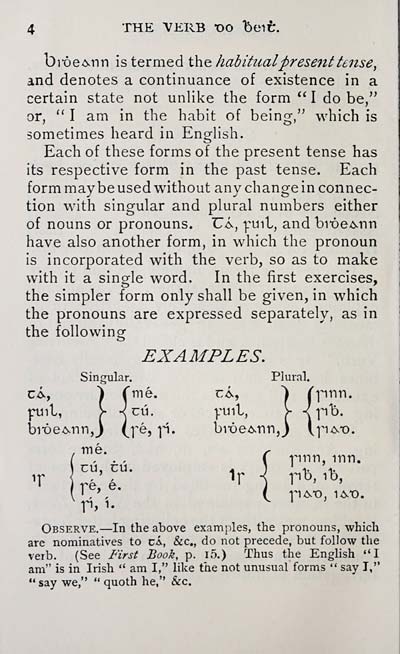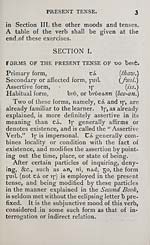Download files
Complete book:
Individual page:
Thumbnail gallery: Grid view | List view

4 THE VERB T>0 bei£.
bi-óe^nn is termed the habitual present tense,
and denotes a continuance of existence in a
certain state not unlike the form " I do be,"
or, " I am in the habit of being," which is
sometimes heard in English.
Each of these forms of the present tense has
its respective form in the past tense. Each
form maybe used without any change in connec-
tion with singular and plural numbers either
of nouns or pronouns. UÁ, put, and bi*oe&nn
have also another form, in which the pronoun
is incorporated with the verb, so as to make
with it a single word. In the first exercises,
the simpler form only shall be given, in which
the pronouns are expressed separately, as in
the following
EXAMPLES.
Singular. Plural.
CÁ, ) ("me. cÁ, ^ fprm.
put, > kcu. yuit, >- <pt).
bi'óe&nn,J (fé, fí. bi^e^nn,} (p&*o.
, . , ( rinn, inn.
I ye, e.
pcvt), 1&T).
Observe. — In the above examples, the pronouns, which
are nominatives to CÁ, &c., do not precede, but follow the
verb. (See First Book, p. l5.) Thus the English «'I
am" is in Irish " am I," like the not unusual forms " say I,"
11 say we," " quoth he," &c.
bi-óe^nn is termed the habitual present tense,
and denotes a continuance of existence in a
certain state not unlike the form " I do be,"
or, " I am in the habit of being," which is
sometimes heard in English.
Each of these forms of the present tense has
its respective form in the past tense. Each
form maybe used without any change in connec-
tion with singular and plural numbers either
of nouns or pronouns. UÁ, put, and bi*oe&nn
have also another form, in which the pronoun
is incorporated with the verb, so as to make
with it a single word. In the first exercises,
the simpler form only shall be given, in which
the pronouns are expressed separately, as in
the following
EXAMPLES.
Singular. Plural.
CÁ, ) ("me. cÁ, ^ fprm.
put, > kcu. yuit, >- <pt).
bi'óe&nn,J (fé, fí. bi^e^nn,} (p&*o.
, . , ( rinn, inn.
I ye, e.
pcvt), 1&T).
Observe. — In the above examples, the pronouns, which
are nominatives to CÁ, &c., do not precede, but follow the
verb. (See First Book, p. l5.) Thus the English «'I
am" is in Irish " am I," like the not unusual forms " say I,"
11 say we," " quoth he," &c.
Set display mode to: Large image | Transcription
Images and transcriptions on this page, including medium image downloads, may be used under the Creative Commons Attribution 4.0 International Licence unless otherwise stated. ![]()
| Early Gaelic Book Collections > Blair Collection > Treas leabhar Gaedhilge > (10) |
|---|
| Permanent URL | https://digital.nls.uk/82321506 |
|---|
| Description | A selection of books from a collection of more than 500 titles, mostly on religious and literary topics. Also includes some material dealing with other Celtic languages and societies. Collection created towards the end of the 19th century by Lady Evelyn Stewart Murray. |
|---|
| Description | Selected items from five 'Special and Named Printed Collections'. Includes books in Gaelic and other Celtic languages, works about the Gaels, their languages, literature, culture and history. |
|---|

